Description
Pharmaceutical forms:
Tablets, Suspension.
Indications:
COPRIMASEPT is indicated for the treatment of the following infections when owing to sensitive organisms:
Treatment and prevention of Pneumocystis jiroveci (P. carinii) pneumonitis
Treatment and prophylaxis of toxoplasmosis
Treatment of nocardiosis
The following infections may be treated with COPRIMASEPT where there is bacterial evidence of sensitivity to COPRIMASEPT and good reason to prefer the combination of antibiotics in COPRIMASEPT to a single antibiotic:
Acute uncomplicated urinary tract infection
Acute otitis media
Acute exacerbation of chronic bronchitis
Consideration should be given to official guidance on the appropriate use of antibacterial agents.
Dosage and administration:
It may be preferable to take COPRIMASEPT with some food or drink to minimize the possibility of gastrointestinal disturbances.
Unless otherwise specified STANDARD DOSAGE applies.
Acute infections:
– Tablets
Adults and children over 12 years: 2 tablets every 12 hours.
– Suspension:
6-12 years: 10 ml every 12 hours.
6 months-5 years: 5 ml every 12 hours.
6 weeks-5 months: 2.5 ml every 12 hours.
This dosage approximates to 6 mg trimethoprim and 30 mg sulfamethoxazole per kilogram body weight per 24 hours.
Treatment should be continued until the patient has been symptom free for two days; the majority will require treatment for at least 5 days. If clinical improvement is not evident after 7 days therapy, the patient should be reassessed.
As an alternative to STANDARD DOSAGE for acute uncomplicated lower urinary tract infections, short term therapy of 1 to 3 days duration has been shown to be effective.
Renal impairment: adults and children over 12 years (no information available for children under 12 years of age).
Creatinine clearance (ml/min) Recommended Dosage
> 30 STANDARD DOSAGE
15 to 30 Half the STANDARD DOSAGE
< 15 Not recommended
Measurements of plasma concentration of sulfamethoxazole at intervals of 2 to 3 days are recommended in samples obtained 12 hours after administration of COPRIMASEPT. If the concentration of total sulfamethoxazole exceeds 150 micrograms/ml then treatment should be interrupted until the value falls below 120 micrograms/ml.
Pneumocystis jiroveci (P. carini) pneumonitis
Treatment:
A higher dosage is recommended, using 20 mg trimethoprim and 100 mg sulfamethoxazole per kg of body weight per day in two or more divided doses for two weeks. The aim is to obtain peak plasma or serum levels of trimethoprim of greater or equal to 5 micrograms/ml.
Prevention:
- Adults
The following dose schedules may be used:
- 160 mg trimethoprim / 800 mg sulfamethoxazole daily 7 days per week.
- 160 mg trimethoprim / 800 mg sulfamethoxazole three times per week on alternate days
- 320 mg trimethoprim / 1600 mg sulfamethoxazole per day in two divided doses three times per week on alternate days.
- Children
The following dose schedules may be used for the duration of the period at risk:
- standard dosage taken in two divided doses, seven days per week.
- standard dosage taken in two divided doses, three times per week on alternate days.
- standard dosage taken in two divided doses, three times per week on consecutive days.
- standard dosage taken as a single dose, three times per week on consecutive days.
The daily dose given on a treatment day approximates to 150 mg trimelthoprim/m2/day and 750 mg sulfamethoxazole/m2/day. The total daily dose should not exceed 320 mg trimethoprim and 1600 mg sulfamethoxazole.
Gonorrhoea
In uncomplicated cases 4 tablets every 12 hours for two days or 5 tablets followed by a further 5 tablets eight hours later or 10 tablets once daily for 3 days.
If poor patient compliance is expected a single dose of 8 tablets taken under supervision may be employed.
Oro-pharyngeal gonococcal infection: 2 tablets three times daily for seven days.
Chancroid
2 tablets twice daily for 7 days. If no evidence of healing is apparent after 7 days a further 7 days treatment can be considered. However, physicians should be aware that failure to respond may indicate that the disease is caused by a resistant organism.
Granuloma inguinale
2 tablets twice daily for up to 2 weeks.
Nocardiosis
There is no consensus on the most appropriate dosage. Adult doses of 6 to 8 tablets daily for up to 3 months have been used.
Brucellosis
It may be advisable to use a higher than standard dosage initially. Treatment should continue for a period of at least four weeks and repeated courses may be beneficial. COPRIMASEPT should be given in combination with gentamicin or rifampicin.
Melioidosis
8 mg/kg/day trimethoprim and 40 mg/kg/day sulfamethoxazole in divided doses, 3 or 4 times per day for 6 months given in combination with ceftazidime or cefoperazone/sulbactam.
Contraindications
COPRIMASEPT should not be given to patients with a history of hypersensitivity to sulphonamides, trimethoprim, co-trimoxazole or any excipients of COPRIMASEPT.
COPRIMASEPT should not be given to premature babies or to full-term infants in the neonatal period.
Warnings and Precautions
− Fatalities, although very rare, have occurred due to severe reactions including Stevens-Johnson syndrome, Lyell's syndrome (toxic epidermal necrolysis), fulminant hepatic necrosis, agranulocytosis, aplastic anaemia, other blood dyscrasias and hypersensitivity of the respiratory tract.
− COPRIMASEPT should be discontinued at the first appearance of skin rash.
− Particular care is always advisable when treating elderly patients because, as a group, they are more susceptible to adverse reactions and more likely to suffer serious effects as a result particularly when complicating conditions exist, e.g. impaired kidney and/or liver function and/or concomitant use of other drugs.
− An adequate urinary output should be maintained at all times. Evidence of crystalluria in vivo is rare, although sulphonamide crystals have been noted in cooled urine from treated patients. In patients suffering from malnutrition the risk may be increased.
− Regular monthly blood counts are advisable when COPRIMASEPT is given for long periods, or to folate deficient patients or to the elderly; since there exists a possibility of asymptomatic changes in haematological laboratory indices due to lack of available folate. These changes may be reversed by administration of folinic acid (5 to 10 mg/day) without interfering with the antibacterial activity.
− In glucose-6-phosphate dehydrogenase (G-6-PD) deficient patients haemolysis may occur.
− COPRIMASEPT should be given with caution to patients with severe allergy or bronchial asthma.
− COPRIMASEPT should not be used in the treatment of streptococcal pharyngitis due to Group A beta-haemolytic streptococci; eradication of these organisms from the oropharynx is less effective than with penicillin.
− Trimethoprim has been noted to impair phenylalanine metabolism but this is of no significance in phenylketonuric patients on appropriate dietary restriction.
− The administration of COPRIMASEPT to patients known or suspected to be at risk of acute porphyria should be avoided. Both trimethoprim and sulphonamides (although not specifically sulfamethoxazole) have been associated with clinical exacerbation of porphyria.
− Close monitoring of serum potassium and sodium is warranted in patients at risk of hyperkalaemia and hyponatraemia.
− Except under careful supervision COPRIMASEPT should not be given to patients with serious haematological disorders. COPRIMASEPT has been given to patients receiving cytotoxic therapy with little or no additional effect on the bone marrow or peripheral blood.
− The combination of antibiotics in COPRIMASEPT should only be used where, in the judgment of the physician, the benefits of treatment outweigh any possible risks; consideration should be given to the use of a single effective antibacterial agent.
Interactions
− In elderly patients concurrently receiving diuretics, mainly thiazides, there appears to be an increased risk of thrombocytopenia.
− Occasional reports suggest that patients receiving pyrimethamine at doses in excess of 25 mg weekly may develop megaloblastic anaemia should COPRIMASEPT be prescribed concurrently.
− In some situations, concomitant treatment with zidovudine may increase the risk of haematological adverse reactions to COPRIMASEPT. If concomitant treatment is necessary, consideration should be given to monitoring of haematological parameters.
− Administration of trimethoprim / sulfamethoxazole 160 mg/800 mg COPRIMASEPT causes a 40% increase in lamivudine exposure because of the trimethoprim component. Lamivudine has no effect on the pharmacokinetics of trimethoprim or sulfamethoxazole.
− COPRIMASEPT has been shown to potentiate the anticoagulant activity of warfarin via stereo-selective inhibition of its metabolism. Sulfamethoxazole may displace warfarin from plasma-albumin protein-binding sites in vitro. Careful control of the anticoagulant therapy during treatment with COPRIMASEPT is advisable. .
− COPRIMASEPT prolongs the half-life of phenytoin and if co-administered the prescriber should be alert for excessive phenytoin effect. Close monitoring of the patients condition and serum phenytoin levels is advisable.
− Interaction with sulphonylurea hypoglycaemic agents is uncommon but potentiation has been reported.
− Concurrent use of rifampicin and COPRIMASEPT results in a shortening of the plasma half-life of trimethoprim after a period of about one week. This is not thought to be of clinical significance.
− Reversible deterioration in renal function has been observed in patients treated with COPRIMASEPT and cyclosporin following renal transplantation.
− When trimethoprim is administered simultaneously with drugs that form cations at physicilogical pH, and are also partly excreted by active renal secretion (e.g. procainamide, amantadine), there is the possibility of competitive inhibition of this process which may lead to an increase in plasma concentration of one or both of the drugs.
− Concomitant use of trimethoprim with digoxin has been shown to increase plasma digoxin levels in a proportion of elderly patients.
− Caution should be exercised in patients taking any other drugs that can cause hyperkalaemia. COPRIMASEPT may increase the free plasma levels of methotrexate.
− If COPRIMASEPT is considered appropriate therapy in patients receiving other anti-folate drugs such as methotrexate, a folate supplement should be considered.
Laboratory tests interactions
Trimethoprim interferes with assays for serum methotrexate when dihydrofolate reductase from Lactobacillus casei is used in the assay. No interference occurs if methotrexate is measured by radio-immune assay.
Trimethoprim may interfere with the estimation of serum/plasma creatinine when the alkaline picrate reaction is used. This may result in overestimation of serum/plasma creatinine of the order of 10%.
Functional inhibition of the renal tubular secretion of creatinine may produce a spurious fall in the estimated rate of creatinine clearance.
COPRIMASEPT may affect the results of thyroid function tests but this is probably of little or no clinical significance.
Pregnancy and Lactation
Trimethoprim and sulfamethoxazole cross the placenta and their safety in human pregnancy has not been established. Trimethoprim is a folate antagonist and in animal studies, both agents have been shown to cause foetal abnormalities. Case-control studies have shown that there may be an association between exposure to folate antagonists and birth defects in humans. Therefore COPRIMASEPT should be avoided in pregnancy, particularly in the first trimester, unless the potential benefit to the mother outweighs the potential risk to the foetus; folate supplementation should be considered if COPRIMASEPT is used in pregnancy. Sulfamethoxazole competes with bilirubin for binding to plasma albumin. As significant maternally derived drug levels persist for several days in the newborn, there may be at risk of precipitating or exacerbating neonatal hyperbilirubinaemia, with an associated theoretical risk of kernicterus; when COPRIMASEPT is administered to the mother near the time of delivery. This theoretical risk is particularly relevant in infants at increased risk of hyperbilirubinaemia, such as those who are preterm and those with glucose-6-phosphate dehydrogenase deficiency. Trimethoprim and sulfamethoxazole are excreted in breast milk. Administration of COPRIMASEPT should be avoided in late pregnancy and in lactating mothers where the mother or infant has or is at particular risk of developing hyperbilirubinaemia.
Additionally, administration of COPRIMASEPT should be avoided in infants younger than eight weeks in view of the predisposition of young infants to hyperbilirubinaemia.
Effects on Ability to Drive and Use Machines
No data.
Side effects
− The frequency categories associated with the adverse events below are estimates. For most events, suitable data for estimating incidence were not available. In addition, adverse events may vary in their incidence depending on the indication.
− Data from large published clinical trials were used to determine the frequency of very common to rare adverse events. Very rare adverse events were primarily determined from post-marketing experience data and therefore refer to reporting rate rather than a "true" frequency.
− The following convention has been used for the classification of adverse events in terms of frequency:- Very common 1/10, common 1/100 and <1/10, uncommon 1/1000 and <1/100, rare 1/10,000 and <1/1000, very rare <1/10,000.
Infections and Infestations
Common: Monilial overgrowth
Blood and lymphatic system disorders
Very rare: Leucopenia, neutropenia, thrombocytopenia, agranulocytosis, megaloblastic anaemia, aplastic anaemia, haemolytic anaemia, methaemoglobinaemia, eosinophilia, purpura, haemolysis in certain susceptible G-6-PD deficient patients
The majority of haematological changes are mild and reversible when treatment is stopped. Most of the changes cause no clinical symptoms although they may become severe in isolated cases, especially in the elderly, in those with hepatic or renal dysfunction or in those with poor folate status. Fatalities have been recorded in at-risk patients and these patients should be observed carefully.
Immune system disorders
Very rare: Serum sickness, anaphylaxis, allergic myocarditis, angioedema, drug fever, allergic vasculitis resembling Henoch-Schoenlein purpura, periarteritis nodosa, systemic lupus erythematosus
Metabolism and nutrition disorders
Very common: Hyperkalaemia
Very rare: Hypoglycaemia, hyponatraemia, anorexia
Close supervision is recommended when COPRIMASEPT tablet is used in elderly patients or in patients taking high doses of co-trimoxazole as these patients may be more susceptible to hyperkalaemia and hyponatraemia.
Psychiatric disorders
Very rare: Depression, hallucinations
Nervous system disorders
Common: Headache
Very rare: Aseptic meningitis, convulsions, peripheral neuritis, ataxia, vertigo, tinnitus, dizziness
Aseptic meningitis was rapidly reversible on withdrawal of the drug, but recurred in a number of
cases on re-exposure to either co-trimoxazole or to trimethoprim alone.
Respiratory, thoracic and mediastinal disorders
Very rare: Cough, shortness of breath, pulmonary infiltrates
Cough, shortness of breath and pulmonary infiltrates may be early indicators of respiratory hypersensitivity which, while very rare, has been fatal.
Gastrointestinal disorders
Common: Nausea, diarrhoea
Uncommon: Vomiting
Very rare: Glossitis, stomatitis, pseudomembranous colitis, pancreatitis
Eye Disorders
Very rare: Uveitis
Hepatobiliary disorders
Very rare: Elevation of serum transaminases, elevation of bilirubin levels, cholestatic jaundice, hepatic necrosis. Cholestatic jaundice and hepatic necrosis may be fatal.
Skin and subcutaneous tissue disorders
Common: Skin rashes
Very rare: Photosensitivity, exfoliative dermatitis, fixed drug eruption, erythema multiforme, Stevens-Johnson syndrome, Lyell's syndrome (toxic epidermal necrolysis)
Lyell's syndrome carries a high mortality.
Musculoskeletal and connective tissue disorders
Very rare: Arthralgia, myalgia
Renal and urinary disorders
Very rare: Impaired renal function (sometimes reported as renal failure), interstitial nephritis
Effects associated with Pneumocystis jiroveci (P.carinii) Pneumonitis (PCP) management
Very rare: Severe hypersensitivity reactions, rash, fever, neutropenia, thrombocytopenia, raised liver enzymes, hyperkalaemia, hyponatraemia, rhabdomyolysis.
At the high dosages used for PCP management severe hypersensitivity reactions have been reported, necessitating cessation of therapy. If signs of bone marrow depression occur, the patient should be given calcium folinate supplementation (5-10 mg/day). Severe hypersensitivity reactions have been reported in PCP patients on re-exposure to co-trimoxazole, sometimes after a dosage interval of a few days.
Rhabdomyolsis has been reported in HIV positive patients receiving COPRIMASEPT suspension for prophylaxis or treatment of PCP.
Overdose
Nausea, vomiting, dizziness and confusion are likely signs/symptoms of overdosage, Bone marrow depression has been reported in acute trimethoprim overdosage.
If vomiting has not occurred, induction of vomiting may be desirable. Gastric lavage may be useful, though absorption from the gastrointestinal tract is normally very rapid and complete in approximately two hours. This may not be the case in gross overdosage. Dependent on the status of renal function, administration of fluids is recommended if urine output is low. Both trimethoprim and active sulfamethoxazole are dialyzable by haemodialysis. Peritoneal dialysis is not effective.
Pharmacodynamics
In Vitro Activity
Sutfamethoxazole competitively inhibits the utilisation of para-aminobenzoic acid in the synthesis of dihydrofolate by the baeterial cell resulting in bacteriostasis. Trimethoprim reversibly inhibits bacterial dihydrofolate reductase (DHFR), an enzyme active in the folate metabolic pathway converting dihydrofolate to tetrahydrofolate. Depending on the conditions the effect may be bactericidal. Thus trimethoprim and sulfamethoxazole block two consecutive steps in the biosynthesis of purines and therefore nucleic acids essential to many bacteria. This action produces marked potentiation of activity in vitro between the two agents.
The affinity of trimethoprim for mammalian DHFR is some 50,000 times less than for the corresponding bacterial enzyme.
The majority of common pathogenic bacteria are sensitive in vitro to trimethoprim and sulfamethoxazole at concentrations well below those reached in blood, tissue fluids and urine after the administration of recommended doses. In common with other antimicrobial agents in vitro activity does not necessarily imply that clinical efficacy has been demonstrated. These organisms include:
Gram Negative
Brucella spp., Citrobacter spp., Escherichia coli (including enterotoxigenic strains), Haemophilus ducreyi, Haemophilus influenzae (including ampicillin-resistant strains), Klebsiella / Enterobacter spp., Legionella pneumophila, Morganella morganii (previously Proteus morganii) Neisseria spp., Proteus spp., Providencia spp. (including previously Proteus rettgeri), certain Pseudomonas spp. except aeruginosa, Salmonella spp. including S. typhi and paratyphi, Serratia marcescens, Shigella spp., Vibrio cholerae, Yersinia spp..
Gram Positive
Listeria monocytogenes, Nocardia spp., Staphylococcus aureus, Staphylococcus epidermidis and saprophyticus, Enterococcus faecalis, Streptococcus pneumoniae, Streptococcus viridans.
Many strains of Bacteroides fragilis are sensitive. Some strains of Campylobacter fetus subsp.
Jejuni and Chlamydia are sensitive without evidence of synergy. Some varieties of non-tuberculous mycobacteria are sensitive to sulfamethoxazole but not trimethoprim. Mycoplasmas, Ureaplasma urealyticum, Mycobacterium tuberculosis and Treponema pallidum are insensitive. Satisfactory sensitivity testing is achieved only with recommended media free from inhibitory substances especially thymidine and thymine.
Pharmacokinetics
After oral administration trimethoprim and sulfamethoxazole are rapidly and nearly completely absorbed. The presence of food does not appear to delay absorption. Peak levels in the blood occur between one and four hours after ingestion and the level attained is dose related. Effective levels persist in the blood for up to 24 hours after a therapeutic dose. Steady state levels in adults are reached after dosing for 2 to 3 days. Neither component has an appreciable effect on the concentrations achieved in the blood by the other. Trimethoprim is a weak base with a pKa of 7.4 it is lipophilic. Tissue levels of trimethoprim are generally higher than corresponding plasma levels, the lungs and kidneys showing especially high concentrations. Trimethoprim concentrations exceed those in plasma in the case of bile, prostatic fluid and tissue, saliva, sputum and vaginal secretions. Levels in the aqueous humor, breast milk, cerebrospinal; middle ear fluid, synovial fluid and tissue (interstitial) fluid are adequate for antibacterial activity. Trimethoprim passes into amniotic fluid and fetal tissues reaching concentrations approximating those of maternal serum.
Approximately 50% of trimethoprim in the plasma is protein bound. The half-life in man is in the range 8.6 to 17 hours in the presence of normal renal function. It is increased by a factor of 1.5 to 3.0 when the creatinine clearance is less than 10 ml/minute. There appears to be no significant difference in the elderly compared with young patients.
The principal route of excretion of trimethoprim is renal and approximately 50% of the dose is excreted in the urine within 24 hours as unchanged drug. Several metabolites have been identified in the urine. Urinary concentrations of trimethoprim vary widely. Sulfamethoxazole is a weak acid with a pKa of 6.0. The concentration of active sulfamethoxazole in amniotic fluid, aqueous humor, bile, cerebrospinal fluid, middle ear fluid, sputum, synovial fluid and tissue (interstitial) fluid is of the order of 20 to 50% of the plasma concentration.
Approximately 66% of sulfamethoxazole in the plasma is protein bound. The half-life in man is approximately 9 to 11 hours in the presence of normal renal function. There is no change in the half-life of active sulfamethoxazole with a reduction in renal function but there is prolongation of the half-life of the major, acetylated metabolite when the creatinine clearance is below 25 ml/minute.
The principal route of excretion of sulfamethoxazole is renal; between 15% and 30% of the dose recovered in the urine is in the active form. In elderly patients there is a reduced renal clearance of sulfamethoxazole.
Pre-clinical Safety Data
Reproductive toxicology: At doses in excess of the recommended human therapeutic dose, trimethoprim and sulfamethoxazole have been reported to cause cleft palate and other foetal abnormalities in rats, findings typical of a folate antagonist. Effects with trimethoprim were preventable by co-administration of dietary folate. In rabbits, foetal loss was seen at doses of trimethoprim in excess of human therapeutic doses.
Special Precautions for Storage
Protect COPRIMASEPT from light.
Keep out of reach of children.
COPRIMASEPT Suspension: Keep at temperature not exceeding 30º C.
COPRIMASEPT Tablets: Keep at temperature not exceeding 30º C, in dry place.
Pack
- A carton box containing 2 (PVC/AL) strips each of 10 tablets and a pamphlet.
- Carton box containing brown (Type III) glass bottle of 100 ml suspension and an insert leaflet.
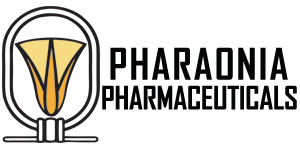

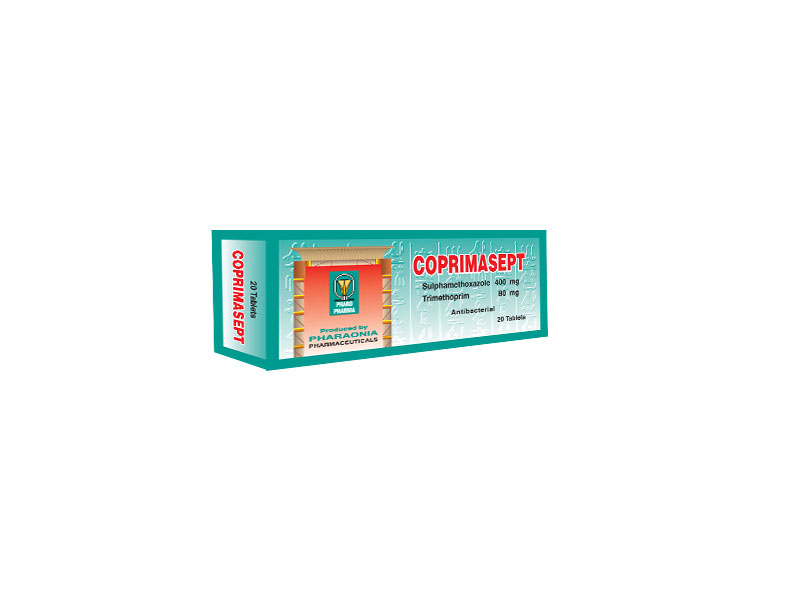

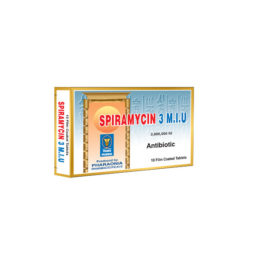
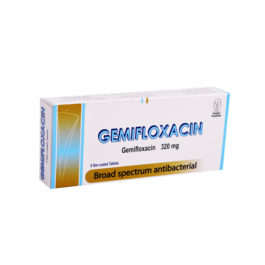
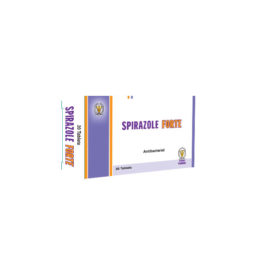

Reviews
There are no reviews yet.